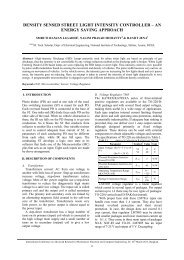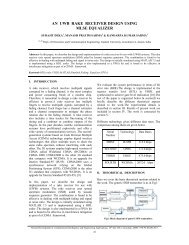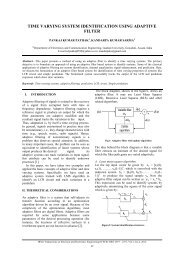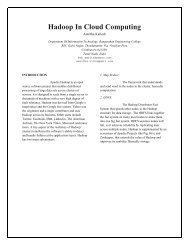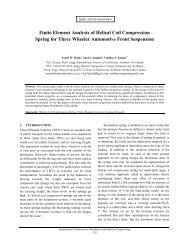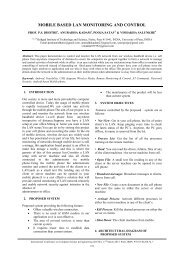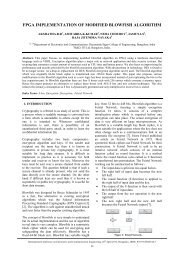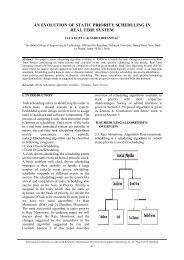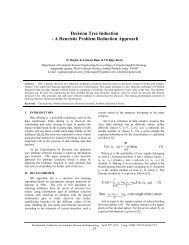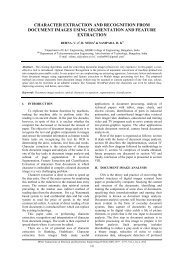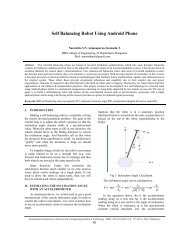FEA based Hydro Test simulation of Pressure ... - IRNet Explore
FEA based Hydro Test simulation of Pressure ... - IRNet Explore
FEA based Hydro Test simulation of Pressure ... - IRNet Explore
- No tags were found...
You also want an ePaper? Increase the reach of your titles
YUMPU automatically turns print PDFs into web optimized ePapers that Google loves.
<strong>FEA</strong> <strong>based</strong> <strong>Hydro</strong> <strong>Test</strong> <strong>simulation</strong> <strong>of</strong> <strong>Pressure</strong> Vessel FilterSachin V. Sangapuri 1, a , S. N. Jalwadi 2, b &Vinaay Patil 3, c1, 2 Mechanical Engineering Dept., Rajarambapu Institute o f Technology, Sakharale, Islampur, Maharashtra, India;3 <strong>FEA</strong> (Finite Element Analysis) Dept, Vaftsy CAE; Pune, Maharashtra, India;E-mail : a sangapuri.sachin@yahoo.com , b sudhindra.jalwadi@ritindia.edu & c vinaaypatil@vaftsycae.comAbstract - The natural gas coming out <strong>of</strong> ores is highly contaminated with sand particles. For further processing <strong>of</strong> natural gas it isnecessary to have contamination free gas. So the air filters are used to clean the gas. Sand contamination can not only wreck thepumps but erode the pipeline so filters have to be installed to exclude the sand from the gas. The filtration <strong>of</strong> gas in industries isessential for enhancing longevity and performance <strong>of</strong> processing line components. This paper investigate the deformation andequivalent von-mises stresses <strong>of</strong> filter plate assembly with changing various patterns <strong>of</strong> filter tube hole with nonlinear staticstructural analysis.Keywords: Finite Element Analysis [<strong>FEA</strong>], Non-linear static structure analysis, Filter Sheet Assembly.I. INTRODUCTIONAn air filter is a device used to decontaminate airthat contains suspended impurities. A major applicationis in form <strong>of</strong> filtration <strong>of</strong> natural gases in petrochemicalindustries. Air filters are generally simple in concept yetthey are technically complicated devices. The filterhelps to mitigate the health effects <strong>of</strong> such gascontaminants by improving the quality <strong>of</strong> air or protectsair handling equipment or costly systems like gasturbine compressors.[1]The function <strong>of</strong> the filter sheet assembly is toprevent the leakage <strong>of</strong> natural gas under allcircumstances since it is a highly inflammable gas.Besides, the environment around a refinery is extremelyhazardous since the possibility <strong>of</strong> an explosion is alwaysimminent. Thus, efficient functioning <strong>of</strong> filter sheetassembly is extremely critical to a refinery.The industries require to design and analyze thefilter assembly.[2]Fig 1 shows an existing filter unit used in oilrefinery. Filter candles have been developed to provideoptimal filtration performance combined with excellentflow pressure loss characteristics, mechanical strengthand corrosion resistance. The candles can be configuredas plain cylindrical or pleated elements in lengths up to3m. Pulsed jet reverse cleaning can be carried out in-situwithout interrupting forward flow and the filters haveintegral ventures to optimize performance. Filter candlescan be supplied fully welded, screwed or flanged andbolted to a tube sheet. The connection provides a highintegrity gasketed and threaded joint, enabling elements<strong>of</strong> filters to be easily assembled to the tube sheet.Support plates are fitted to the base <strong>of</strong> the tube sheet toprovide lateral support and prevent element vibration.Tube sheet assemblies can be supplied to retr<strong>of</strong>itexisting applications for relevant pressure vesselcodes.[2]II. NEED OF ANALYSISIn industry the component produced may be <strong>of</strong>different sizes, from flat plates <strong>of</strong> very simple shape tocomplex 3 dimensional solid bodies. During operationthey may be subjected to various types <strong>of</strong> appliedloading conditions which include centrifugal force,International Conference on Advanced Research in Mechanical Engineering (ICARME-2012), 13 th May, 2012, TRIVENDUM, ISBN : 978-93-81693-59-997
<strong>FEA</strong> <strong>based</strong> <strong>Hydro</strong> <strong>Test</strong> <strong>simulation</strong> <strong>of</strong> <strong>Pressure</strong> Vessel Filterpressure and temperature loading and prescribedboundary conditions. With rising cost <strong>of</strong> material overdesign, the resultant wastage may be extremely costly.Failure <strong>of</strong> component during service may produce a highservice return rate, which is extremely undesirable bothfrom high replacement cost and damage to the prestige<strong>of</strong> product. So stress analysis at the design stage isessential, if service failures are to be avoided and nearoptimum designs are to be achieved for specifiedoperating conditions.III. SCOPE OF PROJECTThis project aims at design and analysis <strong>of</strong> theproposed model <strong>of</strong> the filter sheet assembly to find outstress and deflection in its various components using<strong>FEA</strong> and then optimizing the weight and shape <strong>of</strong> thefilter sheet using iterative <strong>FEA</strong>. The complete projectruns through the following steps:i. Study <strong>of</strong> components <strong>of</strong> existing filter sheetassembly.ii.iii.iv.Study <strong>of</strong> pressures <strong>of</strong> various working conditionscoming on filter sheet assembly.Understanding the design <strong>of</strong> filter sheet.<strong>FEA</strong> <strong>of</strong> existing filter sheet and assembly. From thenonlinear static structural analysis <strong>of</strong> existing filtersheet and assembly the area <strong>of</strong> maximum andminimum stress have been located.v. Weight and shape optimization <strong>of</strong> filter sheet <strong>of</strong>proposed filter sheet assembly by iterative finiteelement analysis.vi.Comparison <strong>of</strong> the basic design and the optimizedmodel for conditions <strong>of</strong> filtering capacity, safety,cost.III. TYPES OF NONLINEARITIESNonlinear structural behavior arises from a number<strong>of</strong> causes, which can be grouped into three principalcategories:A. Contact Nonlinearities: Situations in which contactoccurs are common to many different nonlinearapplications. Contact forms a distinctive andimportant subset to the category <strong>of</strong> changing-statusnonlinearities.[4]B. Geometric Nonlinearities: If a structure experienceslarge deformations, its changing geometricconfiguration can cause the structure to respondnonlinearly.[4]C. Material Nonlinearities: Nonlinear stress-strainrelationships are a common cause <strong>of</strong> nonlinearstructural behavior. Many factors can influence amaterial's stress-strain properties environmentalconditions, and the amount <strong>of</strong> time that a load isapplied.[4]V. DETAILS OF FILTER SHEET ASSEMBLYPartNo123456VI. MODELLINGDescriptionBaseSupportGasketPlateSqGasketFilterPlatePackingPlateTopSupportMaterialSA 516Gr.70SS 304LEPDMrubberSize[mm]Qty50 thk 112 thk 1Sq 8 x 8 1SA 240 40 thk 1SS 304LSA 516Gr.70Table 1: Details <strong>of</strong> Filter Sheet40 thk 440 thk 4Figure 3 shows the 3-D model <strong>of</strong> filter sheetassembly. It is created in modeling s<strong>of</strong>tware CATIAthen exported to ANSYS Workbench, which is requiredfor the purpose <strong>of</strong> further analysis. ANSYS Workbenchprovides a highly integratedInternational Conference on Advanced Research in Mechanical Engineering (ICARME-2012), 13 th May, 2012, TRIVENDUM, ISBN : 978-93-81693-59-998
<strong>FEA</strong> <strong>based</strong> <strong>Hydro</strong> <strong>Test</strong> <strong>simulation</strong> <strong>of</strong> <strong>Pressure</strong> Vessel FilterIX. BOUNDARY CONDITIONThe boundary conditions can be shown in Figure 5.engineering <strong>simulation</strong> platform, supports multi-physicsengineering solutions and provides bi-directionalparametric associativity with most available CADsystems.VII. MESHINGThe filter sheet assembly model is meshed with 10node tetrahedron SOLID186 element. It is a higher order3-D 10-node solid element that exhibits quadraticdisplacement behavior. The element is defined by 10nodes having three degrees <strong>of</strong> freedom per node:translations in the nodal x, y, and z directions. TheelementFigure 5: Loads and constraints on the Filter SheetAssemblyi. The outer edges <strong>of</strong> assembly is fixed as shown inFigure 5ii.iii.iv.The <strong>Hydro</strong>staatic pressure <strong>of</strong> 0.175 Mpa can beapplied on filter plate.Also considering the standard Earth Gravity <strong>of</strong>9.806m/s 2X. RESULTS AND DISCUSSIONAfter giving the solution, the problem is beingsolved in ANSYS by giving the number <strong>of</strong> sub steps fornon linearity. The solution in ANSYS is taking atdifferent conditions Case A: By considering onlyhydrostatic test pressure Max Stress: 37.651 MpaFigure 4: Fine Meshed Model Of Filter SheetAssemblysupports plasticity, hyper elasticity, creep, stressstiffening, large deflection, and large strain capabilities.It also has mixed formulation capability for simulatingdeformations <strong>of</strong> nearly incompressible elasto - plasticmaterials, and fully incompressible hyper elasticmaterials. [7], [8]VIII.WORKING CONDITIONSWorking <strong>Pressure</strong> = 0.07 Mpa<strong>Hydro</strong>static test pressure = 2.5 * working pressure<strong>Hydro</strong> test <strong>Pressure</strong> = 2.5*0.07= 0.175 MpaBlow back pressureBack <strong>Pressure</strong> = 0.08 Mpa + Self WeightFigure 6: Von-Mises Stress PlotInternational Conference on Advanced Research in Mechanical Engineering (ICARME-2012), 13 th May, 2012, TRIVENDUM, ISBN : 978-93-81693-59-999
<strong>FEA</strong> <strong>based</strong><strong>Hydro</strong> <strong>Test</strong> <strong>simulation</strong> <strong>of</strong> <strong>Pressure</strong> Vessel FilterFigure 8: Types <strong>of</strong> Pitch PatternsFigure 7: Total Deformation PlotMax Deformations: 0.1205 mmCase B: By considering hydrostatic test pressure withstandard earth gravity.Max Stress: 37.955 MpaMax Deformations: 0.11829 mmCase C: By considering onlyback pressure.Max Stress: 17.078 MpaMax Deformations: 0.0560222 mmCase D: By considering back pressure with standardearth gravity.Max Stress: 17.691 MpaMax Deformations: 0.058074mmGraph 2 : No <strong>of</strong> elements Vs von-mises StressElement Size[mm]0141516No <strong>of</strong>Element0199736165034138313Deformation[mm]00.118360.118290.11815Von-MisesStress[Mpa]034.08137.95532.304Table 2: Stress and Deformation <strong>of</strong> Filter plateAs seen from the result in table 2 it is foundthat the maximum stress (37.955 Mpa) is inCase B. Theanalysis can be done at element size 15mm (No <strong>of</strong>element=165034). So considering the CaseB for furtheranalysis.Graph 1 : No <strong>of</strong> elements Vs von-mises StresssThevon-mises stress and total deformation can beseen in Figure 7 andFigure 8 respectively. Table 2shows the von-mises stress and Total Deformation <strong>of</strong>Filter Plate Assemblyin Case B at elementsize14mm,15mm,16mm.And Graph 1 shows the No <strong>of</strong>ElementVs Von-mises stress in Case B. In that graphthe element size 15mm gives the peak value(37.955Mpa) <strong>of</strong> stress.It is observed from the analysis <strong>of</strong> all thecomponents <strong>of</strong> proposed filter sheet assembly that thestresses in the components are much less than theiryieldstrengths. Thus it canbe concludedd that the proposeddesign <strong>of</strong> filter sheet assembly is an overdesign, andthere is a scope for optimization to achieve weightInternational Conference on Advanced Research in Mechanical Engineering (ICARME-2012), 13 th May, 2012, TRIVENDUM, ISBN : 978-93-81693-59-99100
<strong>FEA</strong> <strong>based</strong><strong>Hydro</strong> <strong>Test</strong> <strong>simulation</strong> <strong>of</strong> <strong>Pressure</strong> Vessel Filterreduction bygeometry.cutting down certain portion <strong>of</strong> theSo further analysis can be done by changingdifferentpitch patterns. As shown inFigure 8 there arefour types <strong>of</strong> pitch patterns available for optimize thefilter sheet. This maybe noted as the pattern on theexisting filter sheet assembly as well. However, here thedistance between thetwo candles is taken to beminimumm 150 mm; as specifiedin the proposeddrawing. The new pattern now accommodate differentno <strong>of</strong> candles. The detailed analysis is shown in theTable 3.XI. RESULT TABLETheresults coming from doing the various analysisby changing the pitch pattern can be tabulated in Table 3.MeshingTypeTetra-HedronFigure 8: Types <strong>of</strong> Pitch PatternsPattern ElementNo Of Deformation[Von-Mises StressNo OfAngle[°] Size[mm]Elementmm] [Mpa]Candlesorginal165034 0. 1182937.9552130166101 0. 1120534.306204515 162896 0. 1221835.6582360156037 0. 1233730.2283090157224 0. 1294335.88628Table 3 : Stress,Deformation,No<strong>of</strong> candles <strong>of</strong> Filter plate assembly after changing the pitch pattern.CONCLUSIONThe analysis <strong>of</strong> the proposed filter sheet assemblybrought into light a number<strong>of</strong> inadequacies in design.The first thingthat was observed was thepitch pattern<strong>of</strong> the proposed design, which due to increasing distancebetween the candle with increasing radius, ,. A new pitchpattern was selected, which allowed more candles to beaccommodatedd per circular sector filter sheet. The newpitch pattern manages to increase the filtration capacity<strong>of</strong> the. The maximum VonMises stresses after shapeoptimization were found to be less in the shapeoptimized model than those in previously proposedmodel.ACKNOWLEDGMENTWe would like to acknowledge therole <strong>of</strong> Mr.Rahul Lawand, <strong>of</strong> Vaftsy CAE for his guidance in someaspects <strong>of</strong> ANSYS solutions.REFERENCES[1] Robert D. Cook: “Finite Element Modeling For StressAnalysis”, University <strong>of</strong>Wisconsin, Madison, JohnWiley & Sons,1994[2] “Field Assembly Manual”, Bolted LP Reverse Air Filter,Donaldson Company, Inc.[3] Brian Vicich; CraigRyan; Kevin Meredith, “Linear vs.Non-Linear Contactt Analysis”, Samtec, Inc. 2007.[4] Z. Sanal :“Nonlinear analysis <strong>of</strong> pressure vessels: someexamples”,Linde AG, 82049Hoellriegelskreuth,Germany, Received12 September 2000; revised 1December 2000; accepted 5 December 2000[5] “Analysis <strong>of</strong> a Multilevel Iterative Method for Nonlinearfinite Element Equations” RandolphE. Bank and DonaldJ. Rose, Naval Research.[6] “Failure <strong>of</strong> Materials in Mechanical Design” – byJ. A.Collins, Ohio State University.[7] “Finite Element Analysis Theory and Practice” – byM. J.Fagan, University <strong>of</strong>Hull.[8] ANSYS 12.0.1 Tutorial Help.International Conference on Advanced Research in Mechanical Engineering (ICARME-2012), 13 th May, 2012, TRIVENDUM, ISBN : 978-93-81693-59-99101




